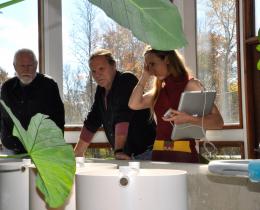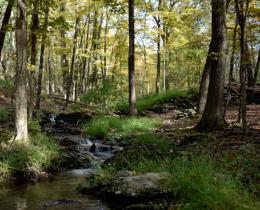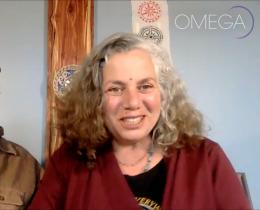The process of restarting the Eco Machine™ will begin with an almost ceremonial action.
Staff will head down to the lake and draw from its edge a bucket or two of mud filled with many of the kinds of organisms that power Omega’s all-natural, chemical-free water reclamation system.
Since Omega closed in 2020 in response to the pandemic, there has been little wastewater to treat—and little food for the countless plants, bacteria, and microorganisms that enable the Eco Machine to treat as many as 52,000 gallons of water a day from campus toilets, showers, and sinks.
All but one of the constructed wetlands were stripped of the cattails and bulrushes that remove odorous gases, support the denitrification process, and harvest nutrients such as phosphorus. The system’s microbial organisms fed on the remaining sludge and then themselves until only 10 percent remained.
Plants in the lush, indoor lagoon have survived only under the careful watch and feeding by staff.
Asking for Nature's Help
The first-ever shutdown of Omega's Eco Machine certainly wasn’t the highest profile impact of the global pandemic. But in many ways, it is one of the more poignantly illustrative. Its closure—and now its reawakening—reflect the interconnected nature of all living things, a lesson humanity has relearned with great cost in the past year.
“We are engaging nature to support the organization again,” Omega CEO Robert “Skip” Backus said. “We are asking for nature’s help.”
The buckets of mud provide the first boost of bacteria and other microbial organisms to the system. Other proprietary microorganisms are being collected from off-campus suppliers. As many as 2,500 tiny reed and cattail plugs are to be planted in the concrete, swimming-pool-sized cells that hold the constructed wetlands. Inside the Omega Center for Sustainable Living’s award-winning building, pumps and filters are being removed and cleaned.
And so little by little, step by step, the symbiotic relationship between the built environment and the natural world, between people and nature, begins to strike a renewed, more abundant balance.
“That,” Backus says, “is one of the things that we are really looking at in terms of our relevancy—our relationship to stewarding the land and climate change.”
The Responsibility of Stewardship
The work is not being limited to wastewater treatment. Omega is reimagining its operations both in terms of public health safety, social, and environmental impact.
Indeed, the Eco Machine has done more than treat countless gallons of wastewater in its more than decade of service. Backus says that ever since he and John Todd—the internationally recognized biologist and developer of the Eco Machine—walked down to the lake to draw the very first buckets of mud in 2009, the Omega community has had to accept and understand the responsibility that comes with stewardship.
“These interconnected relationships are more important than ever to understand,” Backus says. “As we start up the Eco Machine, as we essentially ask nature to welcome participants back to campus, we have to show up. We have to continue to learn how to be in relationship with a natural process and apply that in more ways across the campus.”



